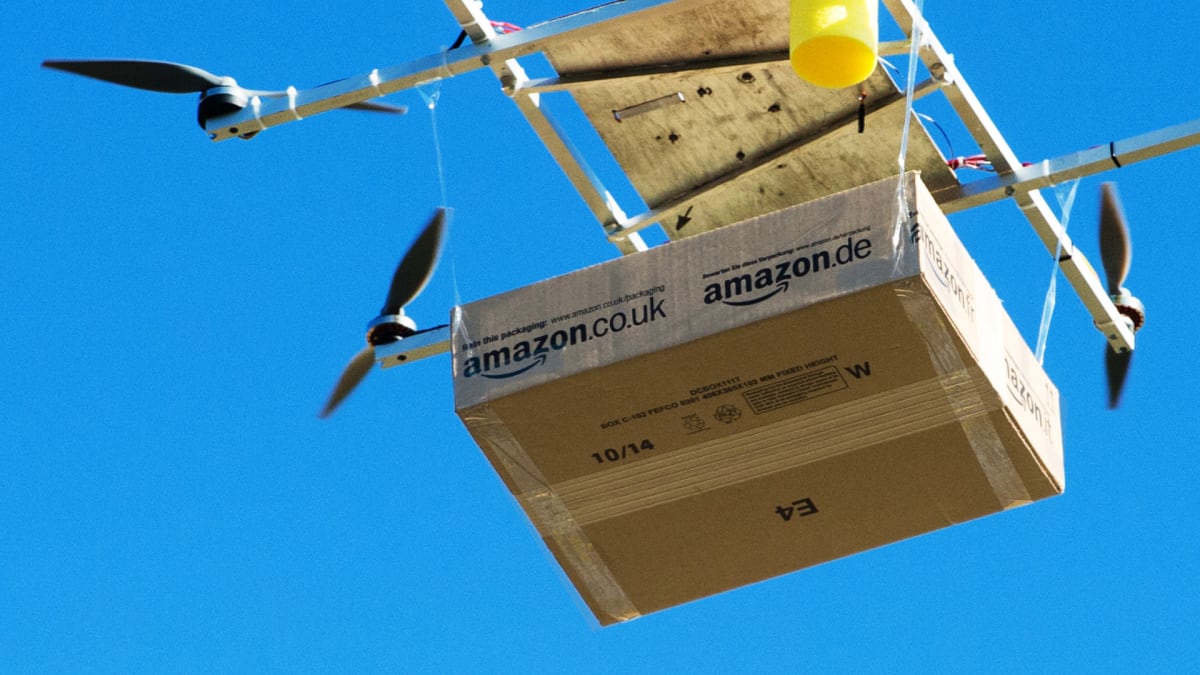
If the future of e-commerce is best represented by Jeff Bezos vs. Elon Musk, then the Tesla Inc. (TSLA) founder holds a decisive edge over his compatriot at Amazon Inc. (AMZN)
That might sound odd since Bezos pioneered the very concept of buying things over the Internet. But Bezos was also the same guy who proclaimed a decade ago on 60 Minutes that remotely piloted drones from Amazon would deliver online orders to your home or office.
Ten years later, Amazon is nowhere close to making that happen. Over the same period, Musk has arguably done more than anyone to advance the idea that self-driving cars, not weird little helicopters, will transport both passengers and goods to their ultimate destinations.
The stakes are huge. E-commerce sales, already booming before the global pandemic, have continued to soar since, along with demand for faster delivery times. Last year, online sales for the first time crossed the $1 trillion mark, nearly double that of 2019, according to data from the U.S. Census Bureau.
Fortune Business insight estimates the global autonomous last mile delivery market to hit $51.4 billion by 2028, compared to $11.12 billion in 2021, a compound annual growth rate (CAGR) of 24.4%.
Here are four reasons why self-driving cars will triumph over drones in the race to dominate the last mile of e-commerce deliveries.
1. Bureaucratic Purgatory
Drones are stuck in bureaucratic purgatory. Despite years of studies, meetings and hearings, the Federal Aviation Administration has yet to issue rules that govern the use of commercial drones.
For the most part commercial companies cannot legally fly drones in the United States. Under a law known as Section 333, the FAA requires anyone operating an aircraft in “national airspace” for commercial use to be a licensed pilot. A drone, by definition, precludes the need for a human to fly inside the vehicle.
A company can apply for an exemption but the agency has granted few of them. As of January 2023, the agency has issued single pilot certificates to only five companies seeking to deliver packages in specific geographic locations, including Wing Aviation, United Parcel Service Inc. (UPS), Amazon, Zipline, and Causey Aviation Unmanned.
Critics say the FAA is moving way too slow. In January, the Government Accountability Office (GAO) released a report that said the agency “has not developed a comprehensive strategy” for drones.
“FAA officials stated they are developing a drone integration strategy,” the GAO report said. “However, the strategy’s release has been delayed multiple times, and whether the strategy will provide a comprehensive approach is unclear.”
“FAA has not clearly communicated the requirements it looks for when reviewing and approving advanced operations. As a result, they faced challenges working with multiple FAA offices on these requests. For example, stakeholders said they experienced lengthy reviews of their requests, and at times received conflicting information from different FAA offices.”
Self driving cars face their own regulatory, safety problems. But companies, including Tesla, Alphabet Inc. (Google), (GOOGL) Dominos, the Kroger Company (KR) Walmart Stores Inc. (WMT) are already testing their vehicles on the road.
2. Amazon Losing Interest?
Bezos ignited the drone crazy with his 60 Minutes interview. The company’s size and clout suddenly made drones top of mind for retailers.
However, Amazon’s efforts have stalled and the e-commerce giant, now under CEO Andy Jassy, seems to lack urgency on the technology. Like many tech giants, the company is now more focused on cutting costs and driving efficiencies.
“Eventually, the FAA will approve drones but I’m not convinced” that drones will be a viable transportation alternative, said Brittain Ladd, who formerly worked as a strategist for Amazon’s grocery business. “It’s a long way off. Frankly, I don’t know why Amazon continues to even have a drone program. Maybe Jeff Bezos said it to distract competitors, mess with their heads.”
3. Economics And Aesthetics Don’t Work
The complexity of drones makes it hard to see how the technology can drive efficiencies in an industry that depends on moving large quantities of goods in the shortest amount of time, Ladd said.
Drones can only carry so much weight so it makes more sense for self driven cars and vans to deliver packages of all shapes and sizes. Some retailers, including CVS Health Corporation (CVS) and Walgreens Boots Alliance Inc. (WBA) are testing drones to transport small purchases like medications and other over-the-counter health and wellness products.
But Ladd said it’s not clear drones would offer an attractive economic return for retailers. Offering drone service, especially if free, might increase consumer loyalty but it would require more work from already busy store employees, he said.
Also, the loud drones, which Ladd calls “flying leaf blowers,” hovering outside people’s homes might startle people. At least people are used to seeing cars and vans on the street, driver or no driver.
4. Need And Urgency For Drones Has Dissipated
The country has significantly changed since Bezos’ interview a decade ago.
In 2013, the increasing density of cities combined with booming online sales presented retailers with logistical challenges.
There was only so much warehouse space that could facilitate last mile deliveries. Retailers, including Amazon, had to almost exclusively rely on the U.S. Postal Service, UPS, and FedEx Corporation (FDX) to deliver online orders. Even those carriers struggled to deliver packages on time, especially during the key holiday season. So drones looked pretty attractive.
But since then, retailers have adapted, using their existing stores as mini-warehouses. Consumers can order online and pick up their purchases at the store, whether at the counter or an outside drive by location.
Retailers have also exploited the proliferation of on-demand contractor companies like Uber Technologies Inc. (UBER), Postmates, and Shipt to make same day deliveries.
And then there’s covid. Research shows that the pandemic has prompted a significant population shift from large metropolitan areas to smaller cities and larger towns/suburbs.
One main argument for drones was that they can more easily traverse the dense, choked neighborhoods of big cities compared with cars that would just be stuck in traffic. But people moving out of the cities saps the urgency to pursue drones.
Drones can still be useful, especially when delivering goods to remote, hard to reach locations. But the technology needs such special attention that it just makes more sense for the good old fashioned car, albeit driverless, to get the job done.







